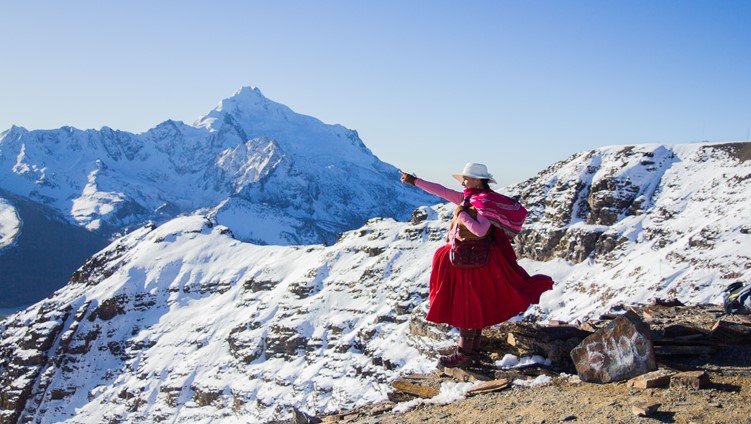We interviewed walking artist Clare Qualmann for our third Edition. Her she discusses a research project investigating the creative and social possibilities of the creative walking necessitated by lockdown.

We interviewed walking artist Clare Qualmann for our third Edition. Her she discusses a research project investigating the creative and social possibilities of the creative walking necessitated by lockdown.
Claire, what is the project, in a nutshell?
Walking Publics/Walking Arts is a research project exploring people’s experiences of walking during the Covid-19 pandemic in the UK. We are particularly interested in the role of creativity – or creative walking - in those experiences. The project will create new resources to support and encourage walking in the pandemic recovery period. Given the many potential benefits of walking - including enjoyment and pleasure, health and wellbeing and walking as a sustainable mode of transport - we think anything that supports more people, and more diverse people, to walk and keep walking will be vital. We have gathered project partners and associates from across the arts and cultural sector and from walking organisations to explore the potentials of creative walking. These include Ramblers Scotland, Paths for All, Living Streets, Sheffield Environmental Movement, Glasgow Life, Open Clasp Theatre Company, Arts Canteen and Museum of London Archaeology (MOLA).
Photo: Clare Qualmann
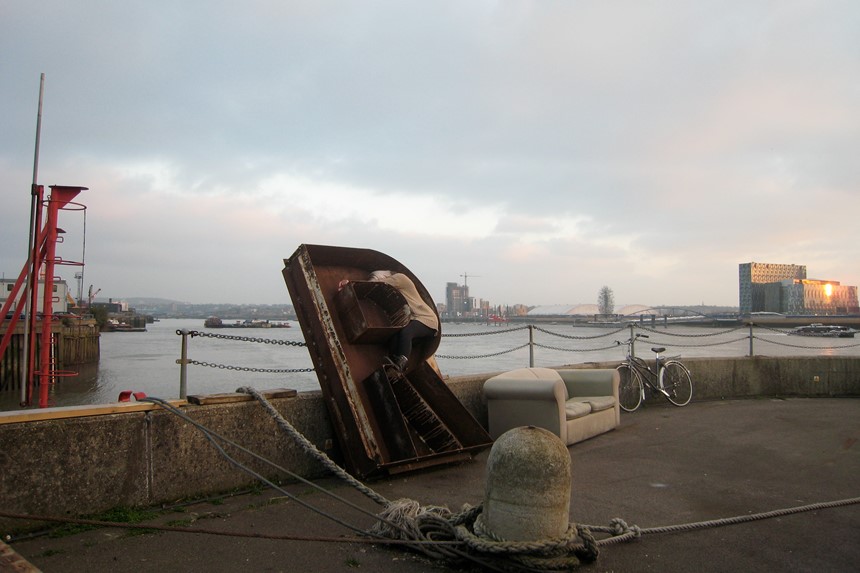
What research and work is Walking Publics/Walking Arts rooted in?
The project team has a range of backgrounds related to walking art, all of which provide a window into the wealth of interesting work in the field.
Professor Dee Heddon, who leads the project, has researched and published on women walking in collaboration with Professor Cathy Turner. Dee also produces The Walking Library in collaboration with Dr. Misha Myers, and with Dr. Sue Porter has used walking to identify and make visible the everyday, embodied knowledges of disabled people through Walking Interconnections.
Dr. Morag Rose founded the creative-walking organisation The Loiterers Resistance Movement, and has published extensively on women walking, walking and disability and psychogeography. Professor Maggie O'Neill was awarded a Leverhulme Trust Fellowship in 2015-2016. Through Walking Borders she used this to employ walking as a method for social research into asylum, migration and marginalisation alongside artists and communities.
The project's Research Associate, Dr. Harry Wilson, is an artist scholar and has been developing work on virtual performance experiences (with an interest in VR/AR).
And then there’s me! I founded Walking Artists Network, and have created a series of walking artworks over the last sixteen years. I also curated the 2016 event series Walking Women for Somerset House, have edited two volumes of Ways to Wander with Claire Hind and taught creative walking in universities.
Photo: Clare Qualmann

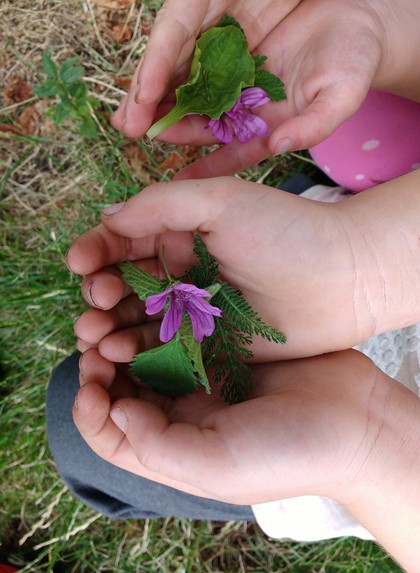
What do you hope to add to this amazing work?
Alongside our research into walking works by artists, we want to explore how individuals and communities have used everyday creative tactics to enliven and encourage walking.
There has been an explosion of activities like coloured-stone trails, ‘wandering’ stones, window ‘wanderlands’ and pavement chalking. A year is a long time to be walking the same paths around the local park, so we are also keen to know if creative activities that can be done while walking, or walks that are themselves creative, have helped sustain people’s motivation, increased their enjoyment in walking or offered ways for people who are physically distanced to connect creatively and imaginatively.
We are using two surveys, one aimed at the general public, and one at artists, to capture information about walking during Covid-19. These are open until May 21st. Once we have analysed the responses we will create an online gallery of creative walking on the project website, and start work on a series of resources that will put into practice what we have learnt and test ideas around the potential of creative walking.
This is where our partnerships really come into play. Through those we will commission a series of artists to create walking works which will draw on the contexts and communities our partner organisations serve. We don’t know what these will be yet, so it’s hard to give examples, but we are excited to see what themes, needs and concerns emerge from the surveys so we can use them to shape the walking artists’ briefs.
We also plan to create a free toolkit of creative walking ideas that will be available on our website, and will hold a walking summit in spring 2022 to share what we have found and gather partners and associates with examples of related research and practice.
Do you sense that Covid could mark a real shift in our approach to walking? If so, how?
Yes! We know that through the most stringent restrictions walking locally was one of the only activities allowed. For much of the past year, the only way to socialise with someone outside your household was to go for a walk together. We think our survey will confirm that many people have walked extensively around their neighbourhoods as a leisure activity, but also as a way of getting around locally. As we have been allowed to venture slightly further afield (even as shops, cinemas and other indoor activities have remained closed), researching and going for new walks has become much more popular. We know that walking is good for your health, as is cultural participation, so we want to find ways to support people to continue doing both.
One aspect of the project is exploring how artists might support such a shift. Do you have any early thoughts on what this might look like?
We know that the cultural sector faces significant ongoing challenges as a result of the pandemic, both in terms of audiences and participation and the increasing need to engage locally. Walking is one of the main activities that can be done safely at the moment, so drawing from walking art’s expertise in structuring cultural experiences through walks has significant potential during the pandemic recovery and beyond. We are keen to help cultural organisations learn more about walking as a creative and cultural activity, and to invite walking organisations to consider a much broader spectrum of walking and walks in their offer to participants. Our goals are increased participation and inclusion, with opportunities for all to access walking and cultural activities that are sustainable and engaging.
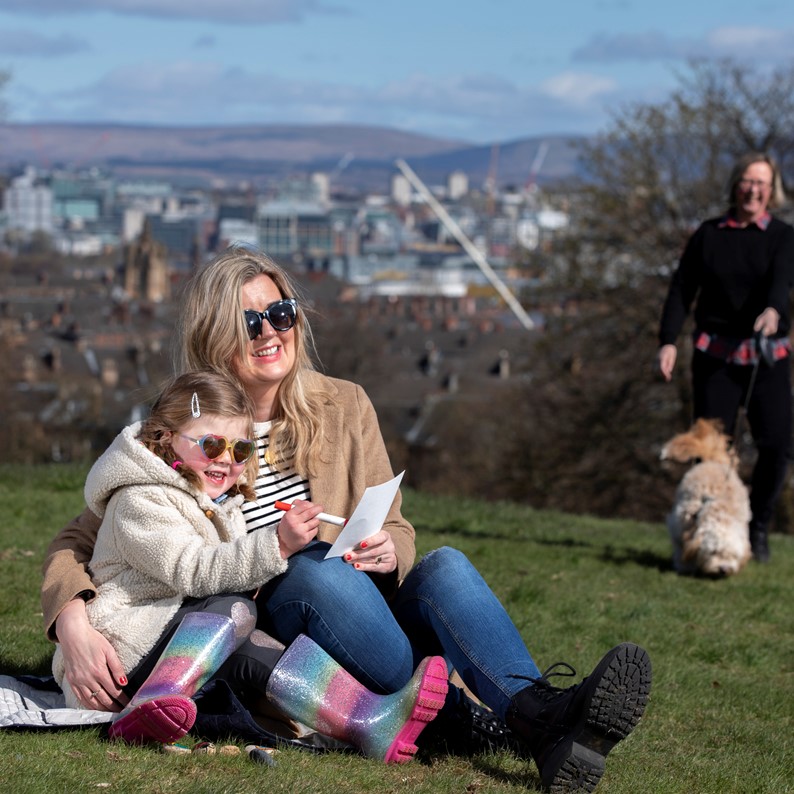
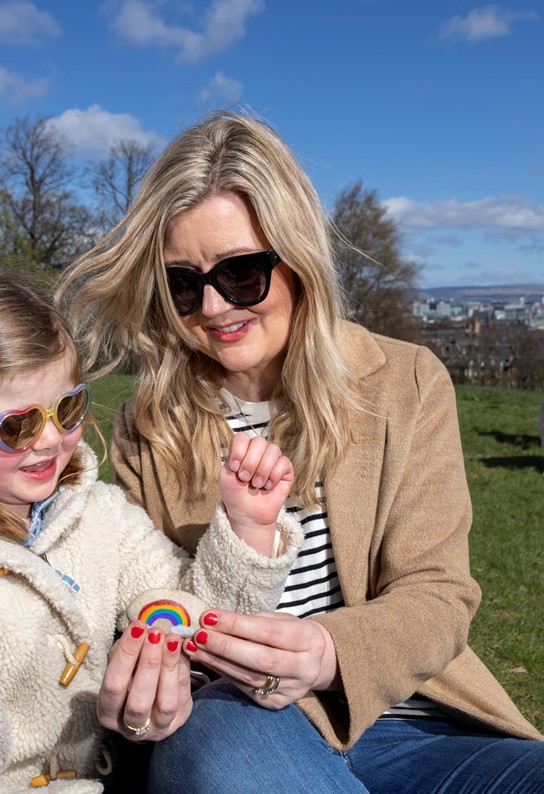

Photos: Martin Shields. Left to right: Emma Gilmartin and daughter Millie (age 4) from Glasgow sitting in the park as Professor Deirdre Heddon walks Rafa the dog; Millie discovering painted pebbles.
'Isolation and disconnection have been, and continue to be, enormous issues under Covid. We know that creative walking can help connect people socially while they are distanced physically.'
What are some of the social issues you think creative walking might help address?
Isolation and disconnection have been, and continue to be, enormous issues under Covid. We know that creative walking can help connect people socially while they are distanced physically. Working from home in sedentary jobs has also reduced many people’s physical activity. Taking part in walks - especially creative walks - can help people stay motivated and keep moving.
We want to emphasise that when we speak about walking, we include walking with wheelchairs and other mobility aids. We also want to explore walking-art practices that might include imaginative walking scapes or experiences that could take place, for example, indoors (virtual walks). This seems particularly important given the context of ongoing shielding, and people experiencing long Covid. Some examples of artworks to this end include proxy walks, like Louise Ann Wilson’s Women’s Walks to Remember and Laura Fisher’s audio work Going in Going Out.
What will be the outputs of this work? How can people get involved?
The first opportunity to get involved is to take part in our surveys, and to share them as widely as possible. Moving forwards there will be opportunities to contribute examples of creative encounters on your walks for our gallery, and in autumn 2021 we will launch a walking toolkit with creative walking tasks and activities for everyone to use. Our walking art commissions will generate new work that will be open for participation (though some of these may be geographically limited), and the walking summit in spring 2022 will combine online and in-person events. Finally, the research team will publish a series of articles sharing the project’s findings.
